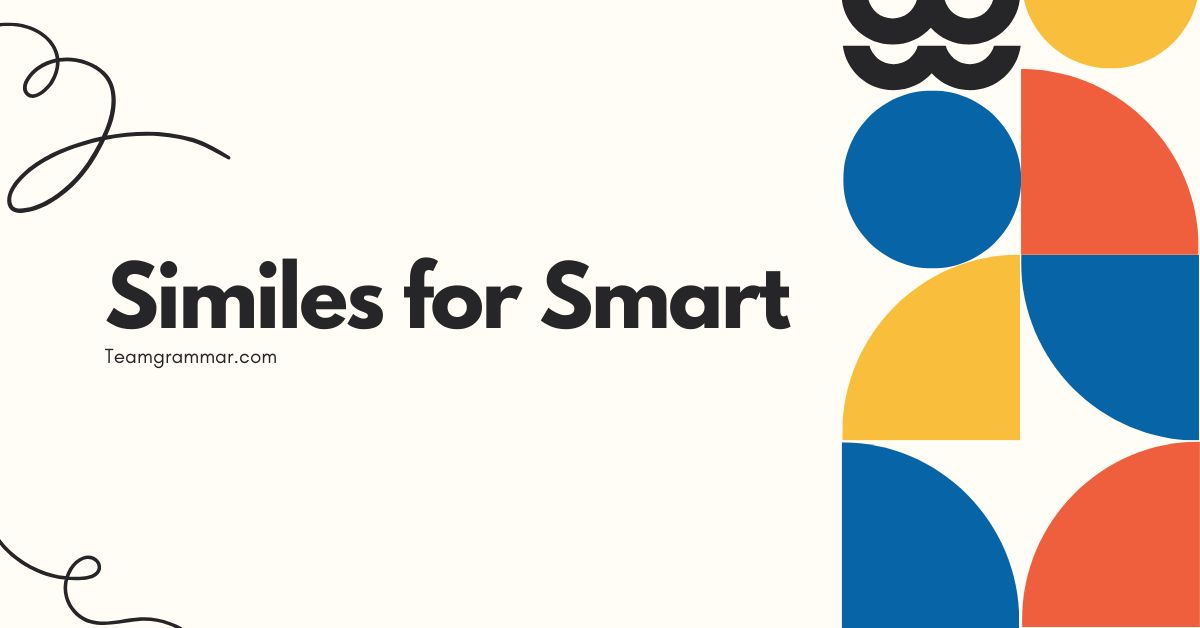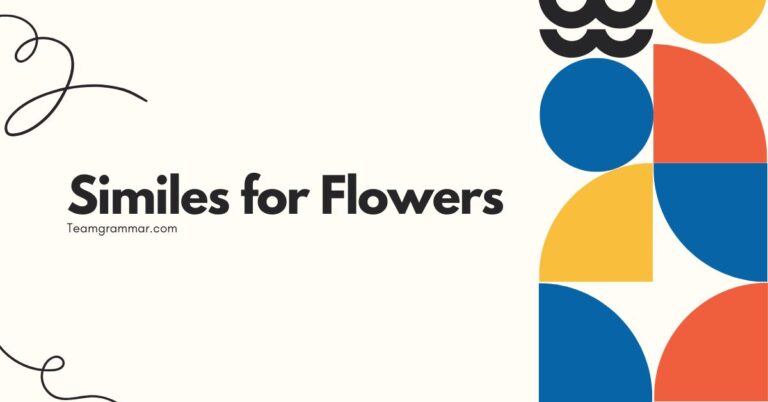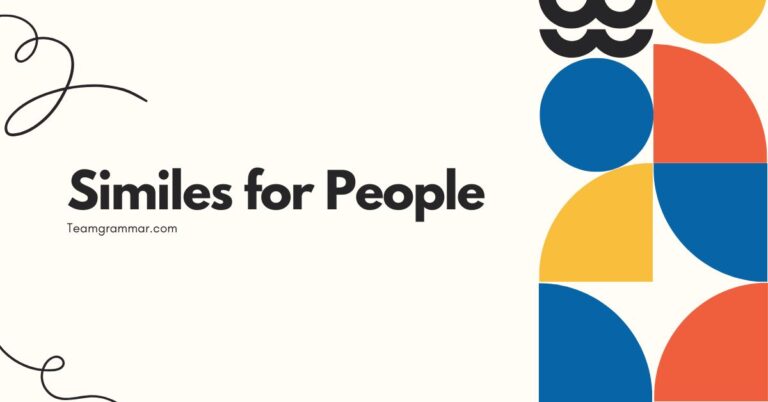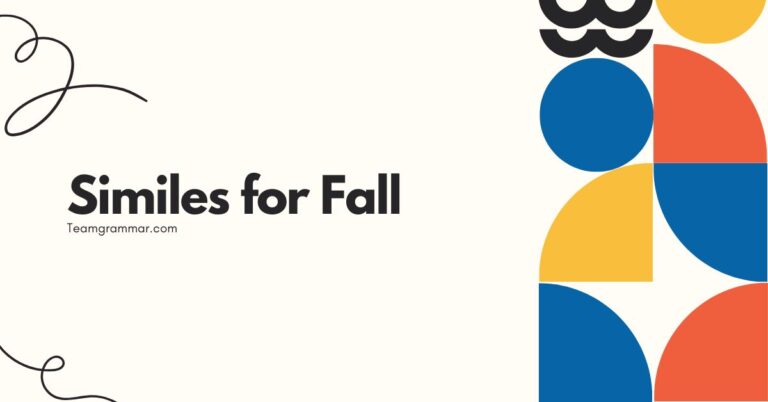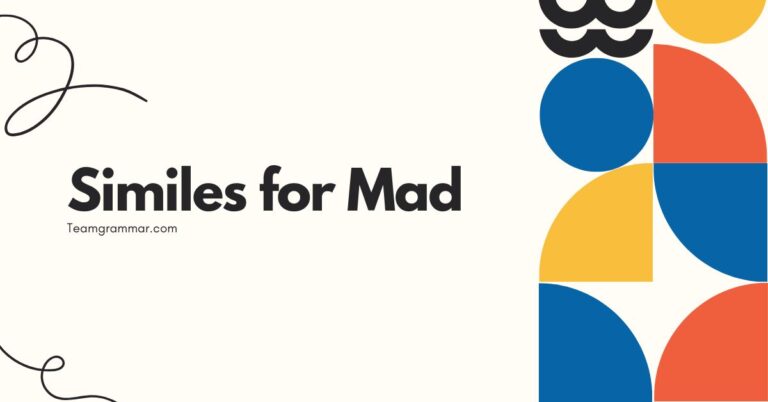29 Similes for Smart: Mastering Figurative Language
Understanding similes is crucial for enhancing your comprehension and expression in English. This article delves into the world of similes used to describe intelligence, offering a comprehensive guide for learners of all levels.
Mastering these figurative language tools will not only enrich your vocabulary but also improve your ability to create vivid and engaging descriptions. This guide is perfect for students, writers, and anyone looking to refine their understanding of English grammar and literary techniques.
By exploring various examples and usage rules, you’ll gain the confidence to use similes effectively in both written and spoken communication.
Table of Contents
- Definition of Simile
- Structural Breakdown of Similes
- Types of Similes for Smart
- Examples of Similes for Smart
- Usage Rules for Similes
- Common Mistakes with Similes
- Practice Exercises
- Advanced Topics in Similes
- Frequently Asked Questions
- Conclusion
Definition of Simile
A simile is a figure of speech that directly compares two different things using the words “like” or “as.” It’s a powerful tool for creating vivid imagery and conveying complex ideas in a relatable way. Similes help to illustrate a quality or characteristic of one thing by associating it with something else that is more familiar or easily understood.
For example, saying someone is “as wise as an owl” uses a simile to suggest that the person is intelligent and knowledgeable.
Similes fall under the broader category of figurative language, which includes metaphors, personification, and hyperbole. Unlike metaphors, which state that one thingisanother, similes only suggest a resemblance.
The function of a simile is to draw a comparison that enhances understanding and adds color to writing or speech. They are used extensively in literature, poetry, and everyday conversation to make descriptions more engaging and memorable.
In the context of describing intelligence, similes can be particularly effective. They allow us to express the nuances of a person’s intellect in creative and imaginative ways.
Instead of simply stating that someone is smart, a simile can paint a picture of their intelligence, making it more impactful and relatable. The choice of simile can also convey different aspects of intelligence, such as quick thinking, deep knowledge, or strategic planning.
Structural Breakdown of Similes
The basic structure of a simile is straightforward: it connects two unlike things using “like” or “as.” This connection highlights a shared quality between the two subjects. Understanding this structure is key to both identifying and creating effective similes.
The structure typically follows this pattern: Subject + Linking Word (like/as) + Object of Comparison.
Let’s break down the components:
- Subject: The thing being described (e.g., a person’s intellect).
- Linking Word: “Like” or “as” – the words that explicitly create the comparison.
- Object of Comparison: The thing the subject is being compared to (e.g., an owl, a computer).
For example, in the simile “His mind was like a steel trap,” “His mind” is the subject, “like” is the linking word, and “a steel trap” is the object of comparison. This structure clearly indicates that the person’s mind is being compared to a steel trap, suggesting that it is quick, efficient, and unwavering.
The effectiveness of a simile depends on the clarity and relevance of the comparison. The object of comparison should be something that is easily understood and that strongly evokes the desired quality.
A well-constructed simile not only makes a comparison but also enhances the reader’s understanding and appreciation of the subject being described.
Types of Similes for Smart
Similes for describing intelligence can be categorized based on the specific aspect of intelligence they highlight. These categories help to refine your choice of simile and ensure that it accurately reflects the intended meaning.
Here are some common types:
Similes Highlighting Knowledge and Wisdom
These similes emphasize the depth and breadth of a person’s knowledge. They often use objects that are associated with learning, experience, or understanding.
Similes Highlighting Quick Thinking and Sharpness
These similes focus on the speed and agility of a person’s mind. They often use objects that are known for their quickness, precision, or sharpness.
Similes Highlighting Strategic Thinking and Planning
These similes illustrate the ability to think ahead, anticipate challenges, and develop effective strategies. They often use objects that are associated with planning, problem-solving, or leadership.
Similes Highlighting Comprehension and Understanding
These similes underscore the ability to grasp complex concepts and understand intricate details. They often use objects associated with clarity, insight, or revelation.
Examples of Similes for Smart
Here are several examples of similes used to describe intelligence, categorized by the specific aspect of intelligence they emphasize. These examples will help you understand how to use similes effectively and creatively.
Knowledge and Wisdom Similes
The following table provides examples of similes that highlight knowledge and wisdom. Each example uses a comparison to illustrate the depth and breadth of a person’s understanding.
| Simile | Explanation |
|---|---|
| As wise as an owl | Owls are traditionally associated with wisdom and knowledge. |
| As knowledgeable as an encyclopedia | Encyclopedias contain a vast amount of information. |
| As learned as a professor | Professors are experts in their fields of study. |
| As insightful as a philosopher | Philosophers are known for their deep understanding of complex issues. |
| As sagacious as a guru | Gurus are spiritual teachers known for their wisdom. |
| As erudite as a scholar | Scholars possess extensive knowledge acquired through study. |
| As deep as a well of knowledge | Suggests an endless supply of information. |
| Like a walking library | Implies a person is a repository of information. |
| As all-knowing as an oracle | Oracles are believed to have access to divine knowledge. |
| His wisdom was like an ancient tree, deeply rooted and vast. | Compares wisdom to the stability and breadth of an old tree. |
| Her mind was as stocked as a well-furnished study. | Suggests a mind full of books and learning materials. |
| As steeped in lore as a seasoned historian | Highlights deep immersion in historical knowledge. |
| Like a compendium of human experience | Implies a vast understanding of life and its complexities. |
| As thoughtful as a monk in meditation | Links wisdom to contemplation and deep thought. |
| His knowledge was like a vast ocean, endless and profound. | Conveys the immensity and depth of knowledge. |
| As wise as Solomon | References the biblical figure renowned for his wisdom. |
| Her understanding was as clear as a mountain spring. | Suggests clarity and purity of understanding. |
| Like a beacon of wisdom in a dark world | Highlights the guiding and illuminating nature of wisdom. |
| As rich in knowledge as a museum is in artifacts | Compares knowledge to the abundance of artifacts in a museum. |
| His mind was like a treasure trove of ancient secrets. | Suggests a mind full of valuable and hidden knowledge. |
| As wise as Yoda | Refers to the wise Jedi Master from Star Wars. |
| Like a fountain of knowledge | Suggests a constant flow of information. |
| As learned as Aristotle | References the ancient Greek philosopher. |
Quick Thinking and Sharpness Similes
This table provides examples of similes that emphasize quick thinking and mental sharpness. These comparisons illustrate the speed and agility of a person’s mind.
| Simile | Explanation |
|---|---|
| As quick as a whip | Whips are known for their fast and precise movements. |
| As sharp as a tack | Tacks have a pointed end that is associated with sharpness. |
| As swift as a cheetah | Cheetahs are the fastest land animals. |
| As agile as a cat | Cats are known for their agility and quick reflexes. |
| As responsive as a computer | Computers are known for their rapid processing speed. |
| His mind was like a steel trap | Suggests a mind that quickly captures and retains information. |
| As quick-witted as a comedian | Comedians are known for their fast and clever responses. |
| Her thoughts were like lightning bolts, sudden and bright. | Compares thoughts to the speed and intensity of lightning. |
| As sharp as a razor’s edge | Emphasizes the precision and keenness of the mind. |
| His intellect was like a finely tuned instrument. | Suggests precision and accuracy in thought. |
| As nimble as a squirrel | Highlights agility and quickness in thought. |
| Her reflexes were like a cobra’s strike, instantaneous and accurate. | Compares reflexes to the speed and accuracy of a cobra’s strike. |
| As alert as a hawk | Implies keen observation and quick response. |
| His mind worked like a well-oiled machine. | Suggests efficiency and precision in thought. |
| As quick on the uptake as a sponge | Compares the ability to absorb information quickly to a sponge. |
| Her brain was like a high-speed processor. | Highlights the speed and efficiency of her mental processing. |
| As perceptive as Sherlock Holmes | References the fictional detective known for his sharp observation skills. |
| His mind was as sharp as a diamond cutter’s tool. | Compares mental sharpness to the precision of a diamond cutter. |
| As incisive as a surgeon’s scalpel | Emphasizes the precision and accuracy of thought. |
| Her intellect was like a laser beam, focused and intense. | Suggests a focused and powerful mind. |
| As sharp as a knife | Suggests a cutting edge intellect. |
| Like a computer processing data | Highlights rapid and efficient information processing. |
| As quick as a hummingbird | Relates to the fast movement and agility of a hummingbird. |
Strategic Thinking and Planning Similes
The subsequent table showcases similes that illustrate strategic thinking and planning. These comparisons highlight the ability to think ahead and develop effective strategies.
| Simile | Explanation |
|---|---|
| As strategic as a chess grandmaster | Chess grandmasters are known for their strategic thinking. |
| As calculated as a mathematician | Mathematicians are known for their precise calculations. |
| As planned as a military campaign | Military campaigns require careful planning and strategy. |
| As methodical as a scientist | Scientists follow a systematic approach to problem-solving. |
| As resourceful as a survivalist | Survivalists are skilled at using available resources to overcome challenges. |
| His mind worked like a well-oiled machine, always calculating and planning. | Suggests efficiency and precision in strategic thought. |
| As cunning as a fox | Highlights the ability to outsmart others through strategy. |
| Her plans were like a blueprint, detailed and precise. | Compares plans to the precision and detail of a blueprint. |
| As organized as a librarian | Emphasizes the ability to manage and structure information effectively. |
| His approach was like a game of chess, always thinking several moves ahead. | Suggests strategic foresight and planning. |
| As forward-thinking as a visionary | Highlights the ability to anticipate future trends and challenges. |
| Her strategies were like a spider’s web, intricate and carefully constructed. | Compares strategies to the complexity and design of a spider’s web. |
| As decisive as a general | Implies the ability to make quick and effective decisions. |
| His planning was like a perfectly executed symphony. | Suggests harmony and precision in planning. |
| As adept at problem-solving as an engineer | Compares problem-solving skills to the expertise of an engineer. |
| Her mind was like a control center, coordinating multiple tasks efficiently. | Highlights the ability to manage complex operations. |
| As strategic as Sun Tzu | References the ancient Chinese military strategist. |
| His approach was like a carefully crafted algorithm. | Compares his approach to the precision of an algorithm. |
| As thoughtful as a game theorist | Emphasizes the ability to analyze and predict outcomes. |
| Her intellect was like a master architect, designing complex structures. | Suggests the ability to create and manage intricate systems. |
| As strategic as a CEO | Suggests high-level planning and decision-making. |
| Like a general mapping out a battle | Highlights strategic planning and foresight. |
| As calculated as a rocket launch | Relates to the precision and planning involved in launching a rocket. |
Usage Rules for Similes
Using similes effectively requires understanding certain rules and guidelines. These rules ensure that your similes are clear, relevant, and impactful.
Here are some key usage rules:
- Clarity: The comparison should be clear and easily understood. Avoid obscure or confusing references.
- Relevance: The object of comparison should be relevant to the subject being described. The shared quality should be apparent.
- Originality: While common similes can be effective, strive for originality to make your writing more engaging.
- Context: Consider the context in which you are using the simile. Ensure that it is appropriate for the audience and the tone of the writing.
- Avoid Clichés: Steer clear of overused similes that have lost their impact. For example, “as busy as a bee” is a common cliché.
Furthermore, pay attention to the connotations of the object of comparison. The object should evoke the desired qualities or associations.
For instance, comparing someone to a “snake” might suggest cunning or deceit, while comparing them to an “eagle” might suggest strength and vision. The choice of object can significantly influence the reader’s perception of the subject.
Consider the cultural background of your audience. Some similes may be more effective or relevant in certain cultures than others.
Be mindful of these differences to ensure that your similes resonate with your intended audience.
Common Mistakes with Similes
Even experienced writers can make mistakes when using similes. Recognizing these common errors can help you avoid them and improve your writing.
Here are some frequent mistakes:
- Mixing Metaphors and Similes: Confusing similes with metaphors is a common error. Remember that similes use “like” or “as” to make a comparison, while metaphors state that one thing is another.
- Using Clichéd Similes: Overused similes can make your writing sound unoriginal and uninspired. Strive for fresh and creative comparisons.
- Creating Unclear Comparisons: If the connection between the subject and the object of comparison is not clear, the simile will be ineffective.
- Using Illogical Comparisons: The comparison should be logical and make sense. Avoid comparing things that have no meaningful connection.
- Overusing Similes: While similes can enhance your writing, using too many can make it feel forced and unnatural. Use them sparingly and strategically.
Here are some examples of common mistakes:
| Incorrect | Correct | Explanation |
|---|---|---|
| He is a lion, like he is brave. | He is as brave as a lion. | The first sentence mixes a metaphor (“He is a lion”) with a simile (“like he is brave”). |
| She was as busy as a bee. | She was as industrious as an ant. | “As busy as a bee” is a clichéd simile. The corrected sentence uses a more original comparison. |
| His mind was like a rock. | His mind was like a steel trap. | “Like a rock” is not specific enough to convey intelligence. The corrected sentence provides a clearer comparison. |
| The idea was as green as a thought. | The idea was as innovative as a breakthrough invention. | “As green as a thought” is illogical. The corrected sentence provides a more logical comparison. |
Practice Exercises
Test your understanding of similes with these practice exercises. For each question, choose the best simile to complete the sentence or identify the error in the simile.
Exercise 1: Completing Sentences
| Question | Answer |
|---|---|
| 1. Her mind was ______________, quickly grasping complex concepts. | As quick as a whip |
| 2. His knowledge was ______________, encompassing a wide range of subjects. | As vast as an ocean |
| 3. Their strategy was ______________, designed to outmaneuver the competition. | As cunning as a fox |
| 4. Her analysis was ______________, revealing hidden patterns and insights. | As sharp as a razor |
| 5. His planning was ______________, ensuring every detail was accounted for. | As methodical as a scientist |
| 6. The solution was ______________, elegantly resolving the complex problem. | As clear as crystal |
| 7. His insights were ______________, providing a fresh perspective on the issue. | As profound as a philosopher’s |
| 8. Her understanding was ______________, allowing her to see the interconnectedness of things. | As deep as a well |
| 9. His intellect was ______________, capable of solving the most challenging problems. | Like a finely tuned instrument |
| 10. Their approach was ______________, anticipating every possible outcome. | As strategic as a chess grandmaster |
Exercise 2: Identifying Errors
| Question | Answer |
|---|---|
| 1. His mind was like a fast car, but he was intelligent. | Error: Illogical comparison. Correct: His mind was as fast as a race car. |
| 2. She was as busy as a bee, and she was smart. | Error: Clichéd simile. Correct: She was as industrious as an ant. |
| 3. His knowledge is a book, like it’s wide. | Error: Mixing metaphor and simile. Correct: His knowledge is as wide as a library. |
| 4. Their strategy was as colorful as a plan. | Error: Unclear comparison. Correct: Their strategy was as intricate as a spider’s web. |
| 5. Her analysis was as green as an idea. | Error: Illogical comparison. Correct: Her analysis was as insightful as a detective’s. |
| 6. His planning was as rock, which was smart. | Error: Grammatical and illogical. Correct: His planning was as solid as a blueprint. |
| 7. The solution was like a light, but very intelligent. | Error: Vague and illogical. Correct: The solution was as clear as daylight. |
| 8. His insights were like a tree, but very knowledgeable. | Error: Vague and incomplete. Correct: His insights were as deep as a forest. |
| 9. Her understanding was as fast, because it’s smart. | Error: Grammatical and illogical. Correct: Her understanding was as quick as lightning. |
| 10. Their approach was the chess, like strategic. | Error: Grammatical and illogical. Correct: Their approach was as strategic as a chess game. |
Advanced Topics in Similes
For advanced learners, exploring more complex aspects of similes can further enhance your understanding and usage. This includes:
- Extended Similes: These are similes that are developed over several sentences or paragraphs, providing a more detailed and nuanced comparison.
- Implied Similes: These are similes where the “like” or “as” is omitted, but the comparison is still implied.
- Juxtaposition: Using similes to create contrast and highlight differences between two things.
- Symbolism: Using similes to convey deeper symbolic meanings and themes.
Consider the use of similes in different literary genres and styles. The effectiveness of a simile can vary depending on the context and the intended audience.
Experiment with different types of similes and explore their potential to enrich your writing.
Studying the works of renowned authors and poets can provide valuable insights into the art of crafting effective similes. Pay attention to how they use similes to create vivid imagery, convey complex ideas, and evoke emotions.
Frequently Asked Questions
Here are some frequently asked questions about similes:
- What is the difference between a simile and a metaphor?
A simile uses “like” or “as” to make a comparison, while a metaphor states that one thing is another. Similes suggest a resemblance, while metaphors imply a direct equivalence.
- Can a simile be a cliché?
Yes, a simile can be a cliché if it is overused and lacks originality. To avoid clichés, strive for fresh and creative comparisons.
- How can I make my similes more effective?
To make your similes more effective, ensure that the comparison is clear, relevant, and original. Consider the context and the intended audience.
- What is an implied simile?
An implied simile is a simile where the “like” or “as” is omitted, but the comparison is still implied. For example, “His mind, a steel trap, captured every detail.”
- How can I avoid using clichéd similes?
To avoid using clichéd similes, brainstorm alternative comparisons that are more specific and original. Consider the unique qualities of the subject you are describing.
- Is it okay to use similes in formal writing?
Yes, it is okay to use similes in formal writing, but use them sparingly and strategically. Ensure that they enhance the clarity and impact of your writing.
- How do I choose the right object of comparison for a simile?
Choose an object of comparison that is relevant to the subject being described and that evokes the desired qualities or associations. Consider the connotations of the object.
- Can a simile be subjective?
Yes, a simile can be subjective, as the effectiveness of a comparison can depend on the reader’s interpretation and understanding. However, strive for comparisons that are generally clear and relevant.
- What makes a simile “good”?
A good simile is clear, relevant, original, and enhances the reader’s understanding or appreciation of the subject being described. It adds color and depth to writing or speech.
- Are similes only used in creative writing?
No, similes are not only used in creative writing. They can also be used in informative or persuasive writing to make complex ideas more accessible and engaging.
Conclusion
Mastering similes is an essential step in refining your English language skills. By understanding the definition, structure, and usage rules of similes, you can effectively enhance your writing and speaking.
Similes provide a powerful tool for creating vivid imagery, conveying complex ideas, and engaging your audience. Remember to strive for clarity, relevance, and originality in your comparisons.
Continue to practice using similes in your writing and speaking. Pay attention to how skilled writers use similes to create impactful descriptions.
By consistently honing your skills, you will become more confident and proficient in using similes to express yourself effectively. With practice, you’ll be able to craft similes that not only describe intelligence but also captivate and inspire your audience.

